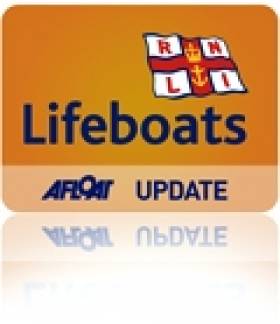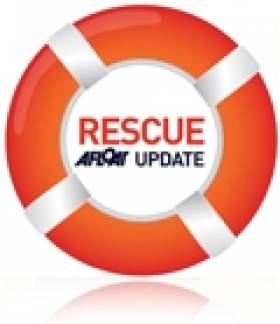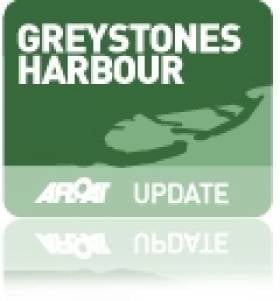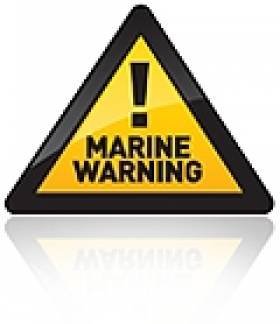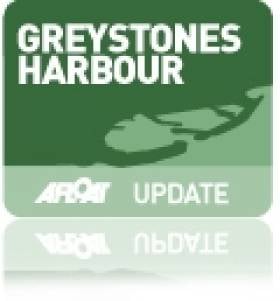Displaying items by tag: Sailors
Sailors & Seabirds
Seabirds and sailors have a long history together. They are reputed to have guided lost sailors to land, led fishermen to catch fish and the sight of them has encouraged many a despairing sailor to realise that land is nearby. From the time a small bird, obviously tired, came out of nowhere to land on NCB Ireland when I was crewing aboard in the then Whitbread Round the World Race, I have been fascinated by how birds fly huge distances over the oceans. That bird stayed for over a day and we were anxious to feed and give it water. Then, sometime in the early dawn it left, heading for I know not where. The legendary Albatross is perhaps the most well-known bird of the seas. Whenever I am sailing in Cork Harbour and see birds dive out of the sky, plunging into and below the water to catch fish, I watch fascinated. When seagulls were being accused of attacking humans in their search for food, it was tme a sign of food lacking at sea as they came inland.
Birdwatch Ireland is the organisation which protects Ireland's birds and their habitats. Fintan Kelly, Policy Officer at Birdwatch, told me this week on the podcast below that one of the most troubling indications of the state of the broader marine environment comes from research carried out on the behaviour of seabirds, because they are excellent indicators of what is happening at and in the sea.
As I said at the outset, seabirds and humans have a long history together, but many species of seabirds are threatened by human activities, which all of us sailors should be concerned about. So I urge you to listen to what Fintan Kelly has to say. You might just think a lot more about the next birds you encounter at sea.
Listen to him on the podcast below where you can also hear how Lifeguards prevented 16,316 marine accidents and keep up with the pace of life on the offshore islands which is quite hectic.
Tom MacSweeney presents This Island Nation maritime programme
Wicklow Lifeboat Tows Yacht to Safety After Rope Fouls Prop
The yacht with two persons onboard was taking part in a race along the Wicklow coast when the mast and rigging was damaged, the skipper attempted to use the engine but a rope had fouled the propeller leaving the vessel drifting helplessly.
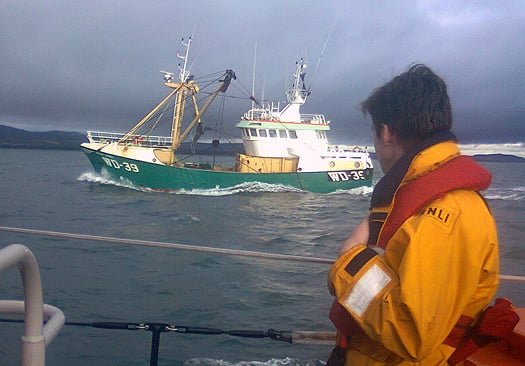
Wicklow lifeboat tows the yacht to safety last night
The lifeboat crew under the command of Coxswain Ciaran Doyle located the stricken yacht about one mile east of the North Arklow buoy and was alongside less than 30 minutes after launching. Once a towline had been rigged by the lifeboat crew the casualty was taken under tow to Wicklow harbour. The yacht was secured alongside the south quay at 7pm and the two sailors were landed safely ashore. This was the second incident the volunteer crew responded to over the weekend.
Five Escape When Yacht Hits Rocks Off Galway
Five sailors had a lucky escape when their yacht hit rocks off the coast of Galway in the early hours of Saturday morning, the Irish Examiner reports.
The crew of five, who had been taking part in the annual Around Aran Race, launched their liferaft when the boat ran aground and raise the alarm from the shore.
Galway's RNLI lifeboat was dispatched to the abandoned yacht in Galway Bay later that morning.
Tricky Winds Make for High Scoring in Palma
Sailing in Palma today, Dun Laoghire's Annalise Murphy had mediocre results compared to yesterday's stellar opening round, dropping her from second overall to 14th in a fleet of 78 boats.
The second day of racing in Palma offered the 1000 sailors racing in the 10 Olympic classes and the 2.4 paralympic event, tricky conditions with moderate and shifty winds. Today's races were sailed in opposite wind directions, with the remaining North-Easterly opening the day but replaced in the afternoon by the expected sea breeze. The committee was able to complete a race for all classes in both winds in moderate conditions averaging 10 knots.
The British team capitalised on yesterday's results to take top placing in three classes.
Olympic Gold medallist and Sailing World Cup leader, Ben Ainslie (GBR) claimed today's races and the lead in the Finn class in front of team mate and earlier leader Giles Scott (GBR), and Pieter-Jan Postma (NED). In the other group the races went to Australian Brendan Casey coached by Finn medallist, John Bertrand (USA) and by junior sailor Jorge Zarif (BRA) coached by Robert Scheidt brother and ex-coach Thomas Scheidt.
Bronze medallists in the 2011 Rolex Miami regatta, Luke Patience and Stuart Bithell add two more victories to their score in the 470 men fleet and climb from 6th to 1st overall. Nick Rogers and Chris Grube (GBR) remain in second overall, three points ahead of Australians Mat Belcher and Malcolm Page.
"The racing was good today, the forecast was right. We started in the offshore wind and came back with the sea breeze. There were different styles going on so it was good to train, keep your eyes out and keep sailing to all the changes going on around you." explained Luke Patience.
Despite winning a race yet, consistent racing brought Nick Dempsey (GBR) in top place in the RS:X fleet. Beijing Bronze medallist, Shahar Zubari (ISR) got to second while Dorian van Rijsselberge (NED) drops to third after suffering in today's conditions. Today's races went to Mashia Nimrod (ISR) and 2008 Olympic champion, Tom Ashley (NZL).
With a total of five races sailed in the event and tricky conditions close to the shore in Palma, the 49ers fleet has collected high scores. The Sibello (ITA) brothers are back on the international circuit after the Sail for Gold regatta. The 2009 European champions are in good form winning two out of three races. They claim the top place four points from early leaders Dylan Fletcher and Alan Sign (GBR).
The Princesa Sofia defending champions, Manu Dyen and Stéphane Christidis (FRA) are taking third overall.
The Japanese AI Kondo and Wakako Tabata (JAP), are conserving the first position in the 470 women fleet with top five results collected in diverse conditions in during the last two days. The Japanese have been training in Palma for the last three weeks with some of the top teams.
"We used to be lacking speed in the breeze but our intense training in Palma has paid off on Monday. We were able to master the breezy conditions and continue with good results today. Lots of other top teams have changed crew like the Dutch or the British so it does give us an advantage." declared Ai Kondo.
The Sail For Gold winners are only two points from Jo Aleh and Bianca Barbarich-Barber (NZL) who claimed today's races. The Princesa Sofia regatta is the first event together as a team for Joe and Bianca who stand in for Polly Powrie who is recovering from a bike crash! The new composed team who has been training together for six days only before the event is collecting great results.
"There was a lot less wind than yesterday. The conditions were good for us. We had lots of fun!" says Aleh.
Australian Tom Slingsby conserves his lead in the Laser fleet with top three results so far. However the day was perfect for Olympic Champion Paul Goodison (GBR) who took two bullets and climbes to second overall only five points from the World Champion. Julio Alsogaray (ARG) is in thrid after winning the day's first race and placing fifth in the next.
In the Radial, Paige Railey (USA) has collected four second places to lead the fleet in front of Marit Bouwmeester (NED). Tania Calles (MEX), Tatiana Drozdovskaya (BLR), Gintare Scheidt (LTU) and Cecilia Saroli (ARG) all win a race today.
The RS:X women fleet has a new leader with Marina Alabau (ESP) racing consistently to a fourth and a second placing: "I am happy with my day, the wind was difficult, light and shifty. I stayed fourth during the whole first race and started the second in the same position but was able to catch up two places and pass Blanca before the finish."
Alessandra Sensini (ITA) didn't perform in the lighter conditions adding twenty points to her score today. She is now in second position overall. Charline Picon (FRA) who had suffered from equipment failure in Monday's windy races, was undefeated today with two bullets. She seats in 12th position overall but could come up in the front when the discard comes in.
Mateus Kusznierewicz and Dominik Zycki (POL) win the first race and claim the lead in the Star in front of Percy/Simpson (GBR) and Scheidt/Prada (BRA). The Italian team of Diego Negri and Enrico Voltolini (ITA) win the second race to place fifth overall.
In the 2.4m, Thierry Schmitter (NED) is keeping the lead in the ten boats fleet after collecting another first and a third.
After a long day on the water Stage One was completed for the Women's Match Racing at the 42nd Trofeo S.A.R. Princesa Sofia MAPFRE in Palma de Mallorca, Spain.
Advancing to the Gold Group are the three undefeated teams (Lehtinen, Barkow and Tunnicliffe) and the three 2nd place teams in each group (Leroy, Hahlbrock, and Macgregor). They will sail a round robin to determine the seeding of the Quarter-Final Knock-out series.
Fighting for a chance to join the Gold Group in the Quarter-Finals are: Skudina, Roca, Groeneveld, Souter, Le Berre, and Hazard. They will sail a round robin with the top two advancing.
The remaining 12 teams will continue racing in the Silver and Bronze groups to determine places 13 through 24 in the event.
Racing will resume on Wednesday at 10am for the Women match racing and 11am for the other classes.
All our Olympic news HERE
O'Leary and Burrows Pipped by Single Point for Bacardi Honours
France's Guillaume Florent and Pascal Rambeau accomplished a rare achievement in Saturday's finale of the 84th event Cup.
Florent, the 2008 Olympic bronze medalist in the Finn class who switched over to Star keelboat last year, won the prestigious regatta at his first attempt.
O'Leary and Burrow's second overall in the 93-boat fleet is being hailed as a major result for the pair who have sights firmly set on selection for the London 2012 Olympic Games.

Peter O'Leary and David Burrows (centre) receive the Bacardi Cup second place salver in Miami yesterday. Photo: Courtesy Bacardi Cup/Star Class
Their final score after six races that began on Monday was 24 — only one point behind the French duo.
In a consistent display of speed and tactical ability against a big international fleet only Ireland posted the most consistent scores of the series with all results in the top ten.
Racing in the event was cut short due to thunderstorms on Thursday.
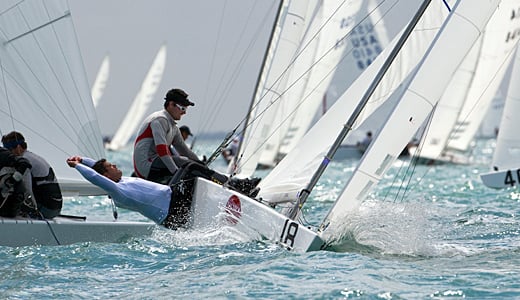
Peter O'Leary with crew David Burrows at full stretch at the weather mark. Photo courtesy Bacardi Cup
O'Leary and Burrows recorded single-digit finishes over the course of the regatta; they finished with an 8-4 on the penultimate day to move from fourth overall into the lead of the 89-boat fleet with 18 points only to lose out in the final race.
Full Results HERE.
Star Class website/results/comment HERE
Photos of O'Leary and Burrows in action on our gallery HERE
Podcast interview and Career highlights of Peter O'Leary HERE
Cruise from Kinvara to Tahiti Wins Sailor of the Month Award
Recognised by the senior offshore sailing organisation, the Irish Cruising Club, with the award of the historic Faulkner Cup, the Quinlan's achievement is further enhanced by the fact that, in their determination to acquire a boat suitable for long distance voyaging, they built their steel-constructed 40ft cutter Pylades themselves, launching in 1997.

They have brought a lively and enquiring eye to the complex project, something which reflects Fergus's qualifications as an architect. As he has drily observed himself, there isn't a lot of work around for architects in Ireland at the moment, so everything clicked with the boat sea-tested and ready to go off on this sail of a lifetime.
Having left Kinvara in June 2009, their longterm plan is a global circumnavigation, returning to Galway Bay in August 2012. Quite what Ireland will be like by then is anybody's guess. But as it is, the crew of Pylades have enough to be getting on with in dealing with the vagaries of the open ocean, and the volatile political situation in some of the areas where ocean voyagers go. For armchair sailors at home, their thoughtful and entertaining reports on their experiences make them worthy "Sailors of the Month".
Greystones Harbour Open Day Gives Chance to See Impressive Marine Works
This is a chance, says local councillor Derek Mitchell, to see what has been achieved behind the hoardings in the last two years. "All marine works will be finished in 2010 and it is impressive to see what has been achieved. Currently much of the earth stored on top of D'Arcys field is being moved to beside the new harbour and it is quite mucky which limits the area which the public can access. However it will be a good chance to see behind the hoardings" Mitchell told Afloat.ie.
The next stage will start in January and finish in December 2011 after which most hoardings will come down. This stage consists of the 4 storey Health Centre, public square and free clubhouses for the Sea Scouts, Rowers, Divers, Sailors and Anglers.
Full Moon Prompts Weekend Safety Warning
Spring Tides and an uncertain weather forecast can make this weekend more hazardous than usual.
Irish Water Safety is reminding boaters, sailors, surfers, divers and anglers that there is a full moon on Saturday so they need to be aware of spring tides for the weekend coupled with an uncertain weather forecast.
It is important to take a good weather forecast and to factor this in to their plans accordingly. In addition we wish to remind you of the shorter daylight hours and not to be too ambitious when passage planning over the weekend.
On average 153 people drown in Ireland each year so it is essential to wear suitable protective clothing and a properly serviced and fitted lifejacket when on the water and avoid taking unnecessary risks, especially taking alcohol or drugs as approximately 30% of all drowning victims will have consumed alcohol.
Anglers will be at risk and non nationals in particular should be extremely vigilant as the Atlantic swell is dramatically different to that experienced on the relatively calmer Baltic Sea to which many are accustomed.
It is essential that parents or responsible adults supervise their children at all time when near water.
Walkers should remain alert and stay well away from the edge of ordinarily familiar waterside pathways due to the risk of stranding as a result of the high tides.
Remember your lifeline in an emergency is 999 and 112 therefore carry a mobile phone and ask for the Marine Rescue.
If you discover missing or found Ringbuoys then log on to www.ringbuoys.ie to report them, remember, "a stolen ringbuoy is a stolen life"
Greystones Harbour Facilities to be Complete by End 2011
Tuesday nights Greystones Town Council meeting was informed by Greystones harbour developer Sispar that the major work on the seawalls would be complete at the end of November 2010.
Following this, construction of the Health Centre, public square and Community buildings for the Sea Scouts, Rowers, Anglers, Divers and Sailors will start in January and should be complete in December 2011.
The hoardings which have blocked the view of the harbour and proposed marina will be taken down as these works are completed in 2011.
Local councillor Derek Mitchell (and a Ruffian keelboat champion) told Afloat.ie: "I welcome this as Greystones had been trying to get the harbour rebuilt for over a hundred years and this will create the best Community Harbour in Ireland".
Councillor Mitchell adds "The developer has applied to change some of the housing and add 34 houses to the North. Wicklow County Council is to vote on this in December. These houses may not be built yet, depending on the housing market, but access will be provided across the site to the North Beach and the new swimming beach there"
"The meeting was also told that the loan would be going in to NAMA, as all loans will, however this is not expected to make any difference to the project", he added.
Councillors asked for more Community tours so that people could see what has been achieved.




























